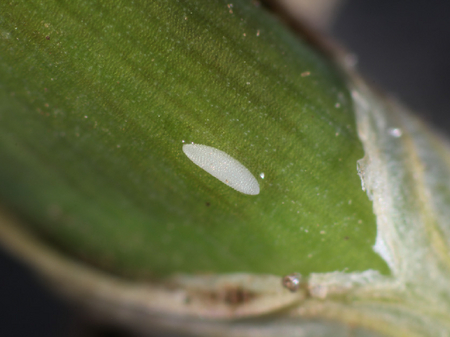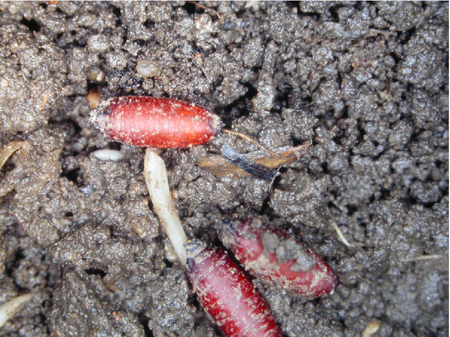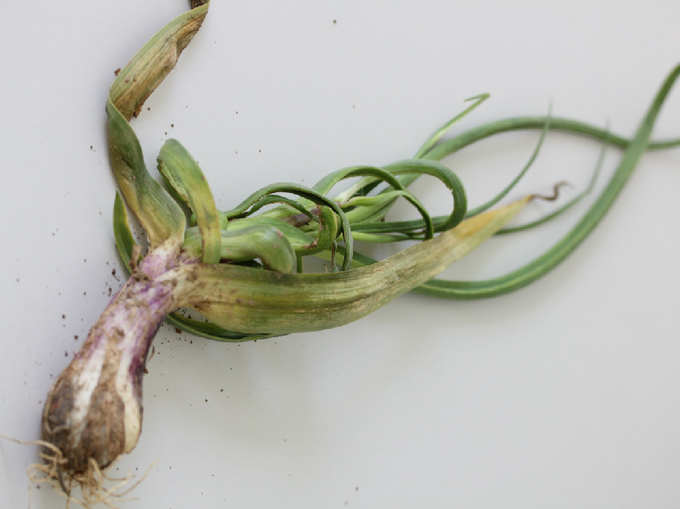Suillia lurida
Suillia lurida
Appearance
The garlic fly belongs to the midge family (Heleomyzidae), is about 9-10 mm long and has a wingspan of about 18 mm. The body is red-brownish, the wings are mostly transparent and have a grey shimmer along the wing veins. Like all flies, it has a wing cup instead of hind wings.
The eggs are white, approx. 1.2 mm long and spindle-shaped with a highly textured surface.
The maggots reach a size of up to 10 mm and have a pointed front end on which the mouthparts shine through as "nail hooks". The strongly hardened breathing openings (stigmas) open at the rear end.
The pupae of the garlic fly are oval, reddish-brown and about 7 mm long. They are barrel-shaped pupae, which are generally characteristic of flies.



Biology
In early spring, as soon as the first garlic shoots appear, the flies visit garlic fields. The eggs are laid in the soil near the base of the stem. The peak of egg-laying occurs in the first half of April, although warm periods in winter can lead to earlier egg-laying. The garlic fly passes through three larval stages.
The newly hatched larvae bore into the shoot and feed on the young leaves. Around mid-May, they leave the garlic plants and pupate in the surrounding soil. Flies hatch from the pupa at the beginning of June. However, these do not cause any more damage, they overwinter and do not reproduce until the following spring.
Damage symptoms
Initial infestations are usually not noticed as the maggots feed on the innermost, young leaves. Their feeding only becomes visible when the affected leaves are pushed outwards as they grow. From April to May, the fly larvae can be found in the winter garlic shoot. From the end of April/beginning of May, the damage is also visible on the outside.
In spring, the innermost, newly appearing leaves show traces of feeding by the fly maggots to varying degrees: these range from jagged, frayed lateral edges with bending and twisting of the leaf to complete stunted growth in the main shoot.
In such cases, numerous weaker side shoots are often formed. The plant then takes on a "grass-like" appearance and the garlic cloves remain small.


Host plants
This pest only attacks winter garlic, but not summer garlic grown in spring. There are also differences between individual varieties with regard to susceptibility: the landrace of garlic used in the Weinviertel region is less severely infested or can survive an infestation better. In addition to garlic(Allium sativum L.), the garlic fly was also observed on onion(Allium cepa L.) and leek(Allium porrum L.).
Prevention and control
- One preventative measure is to cover the garlic with a crop protection net or fleece. However, this must be done as early as the first warm days of spring. The crop should then remain covered until around the middle/end of April.
- The choice of variety is also important, as stem-forming garlic varieties are less affected. In addition, damage has less of an impact there.
- Chemical measures include spraying with preparations against biting insects or suitable for controlling seed or root flies (see list of plant protection products authorised in Austria). Experience has shown that the best time for treatment is around the beginning of April, when 10 % of the plants examined are covered with eggs. The preparations are ineffective at low temperatures. In any case, a wetting agent should be added to the spray mixture.
Last updated: 07.08.2025
automatically translated